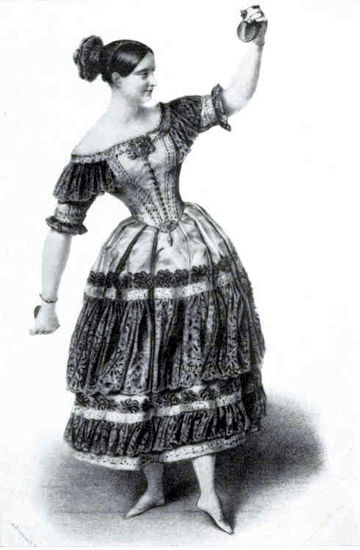Fanny Elssler (1810-1884)

Based on what has been written about her, Marie Taglioni was apparently a one-dimensional dancer mastering the romantic style, but her rival Fanny Elssler performed a range from character to what was called classical. She was born Franziska Elssler June 23, 1810, in Vienna. Her father, Joseph Ludwig Ferdinand, was the valet and copyist of Joseph Haydn. Haydn did not pay well, and Fanny's mother had to take in washing to help support their six children. However, Haydn did send his valet's two youngest daughters, Fanny and Theresa, to study ballet with Friedrich Horschelt, and later with Jean Aumer, the ballet master at the Kaernterthor Theatre in Vienna. Theresa was tall and appeared en travesti, partnering her sister Fanny. When Fanny was twelve she was taken into the corps de ballet of the Hoftheater, where Fillipo Taglioni was Ballet Master.
In 1822 Fillipo was ready to debut his daughter Marie in a ballet designed especially for her, LA RECEPTION D'UNE JEUNE NYMPHE A LA COUR DE TERPSICHORE. Fanny and her sister were in the corps de ballet. A short while later, Fanny left for Naples. Fanny and Marie would not meet again until 1833, when both dancers would dance at the King's Theatre in London.
In Naples, Fanny was a great success and also became the mistress of Prince Leopold of Salerno. Their son Franz was born when Fanny was 17 years old. This was kept secret, and Franz was placed in a foster home so that Fanny could continue her promising career. Fanny was a beautiful women and made use of every charm she possessed.
Frederich von Gentz was 65 and Fanny 19 when he took it upon himself to educate her in cultured German and French. This alliance, which began in 1829, lasted until his death. Her devotion to him kept her at his bedside, where she maintained a vigil until his death in 1832.
While Therese and Fanny were dancing in Berlin. Fanny fell in love with Anton Stuhlmuller and bore him a daughter. Little Therese was raised by Harriet Grote, the wife of a member of the British Parliament.
Fanny never took her talent for granted and constantly honed her art. In 1834, Dr. Vernon of the Paris Opera brought her to Paris to give Marie Taglioni competition. Fanny spent three months with Auguste Vestris before she danced at the Opera. She was an instant success. The audience, divided into two camps, said of the two rivals that Taglioni was a Christian dancer and Elssler a pagan dancer. The poet Theophile Gautier said of Elssler, "After all, dancing consists of nothing more than the art of displaying beautiful shapes in graceful positions...Mlle. Fanny Elssler has fully realized this truth..."
Against all advice, Fanny Fanny danced LA SYLPHIDE in 1838. No one had a good thing to say about this performance.
In 1840, when Fanny Elssler came to America for a three-month visit, the President of the United States and his cabinet received her in an official audience. Congress adjourned every evening that she danced in Washington. At a formal banquet in the Capitol the Congressmen drank to her health from a dance slipper. The three month's visit lasted two years.
Elssler came to America on the -Great Western_, with a small entourage. Although the crossing was rough it was uneventful except for one incident. The captain gave a dinner in Elssler's honor, at which she wore all of her jewelry. Upon her return to her cabin, a stocky sailor crept in, armed with a knife and intent on stealing her jewels. Impulsively, she did a quick turn and kicked him so hard he died a few days later. (I do not know where she kicked him, but I smart at the thought).
Less than two weeks after landing in New York she assembled the best dancers she could and made her debut on May 14. The audience went wild and the Park Theatre was sold out for her entire stay. No matter what she danced or how well, the ovation was the same. Flowers blanketed the stage. A red carpet was stretched in front of the Park Theatre and it was not unusual for men to unharness her horses and pull her carriage from the theatre to her hotel after her performances.
Fanny danced at West Point, and when she left, the guards on duty would not let her pass until she danced for them. She made a successful second tour of America and Cuba. But despite all of the Elsslermania, after she left, dance in the USA went back to something between tight-rope walkers and fancy dancing.
Fanny Elssler danced until she was forty-one. She danced with undiminished success in London, Vienna, Berlin, Brussels, Budapest, St. Petersburg, Moscow and Naples. She was welcomed everywhere but at the Paris Opera: the Management could not forgive her for the breach of contract when she overstayed her leave in America. Jules Perrot's ballet FAUST in 1851 was Elssler's last performance. Fanny died in her native Vienna on November 27, 1884, at the age of seventy-four. She also died a millionaire.
(First published April 1993)